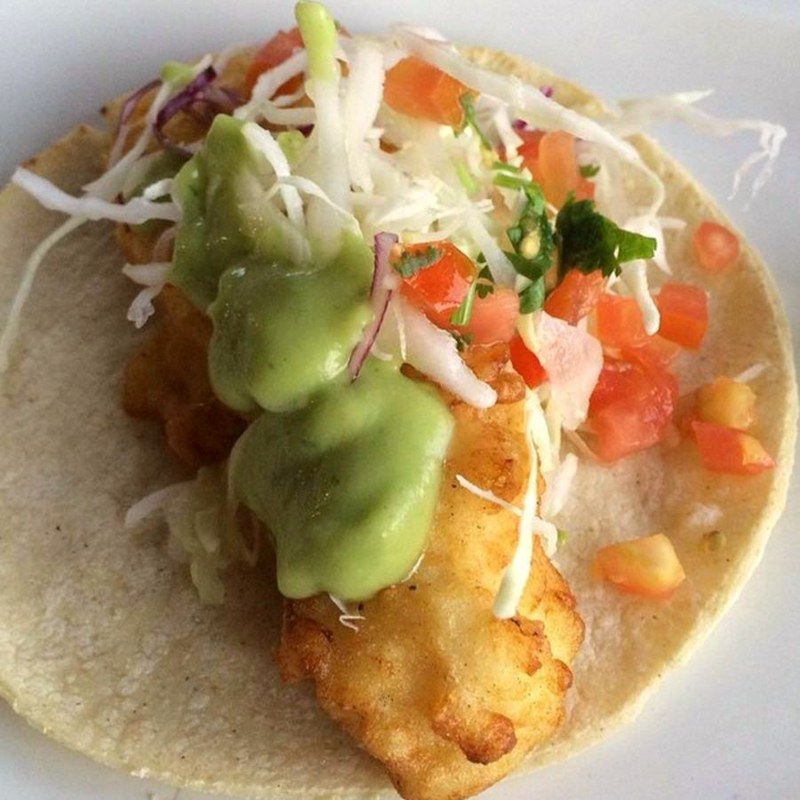What’s the true story behind iconic Baja creations like the fish taco, margarita and Caesar salad? The origin stories of all three are shrouded in so much mystery and legend, rumor and innuendo, that’s it hard to make definitive statements about any of them. We’ve done our best, however, to sort through the various backstories and uncover the most likely scenario for each, using a tried and true methodology known as Occam’s razor. Translation: the most likely explanation is probably the one closest to the truth.
The Baja Fish Taco
Fish and tortillas have been around in Mexico for so long that they were almost certainly paired up in the distant past. But the modern fish taco, the Baja style fish taco that we’ve all grown to know and love–a batter fried white fish wrapped in a corn tortilla, and served with shredded cabbage, salsa and a squeeze of lime–does have a traceable origin. The primary difference of opinion is whether the birthplace was San Felipe or Ensenada.

The fish taco became popular in the U.S. because of Ralph Rubio, whose portfolio of restaurants now includes over 200 eateries. Rubio’s introduction to the fish taco was during a Spring Break trip from San Diego to San Felipe in 1974, at a stand operated by a man named Carlos. Rubio got the recipe and the rest became SoCal and later Southwest history after he opened the first Rubio’s Fresh Mexican Grill in San Diego in 1983.

The case for San Felipe mainly rests on the Rubio connection, while Ensenada’s fish taco bona fides can be traced back to the opening of its famed fish market in 1958. Ensenada natives believe the fish taco and its modern incarnation began there, and point to their own secret ingredient–a splash of Pacífico beer from a ballena, or liter-sized bottle–which gives the batter its distinctive fluffiness when fried.
The Most Likely Truth: The modern fish taco was definitely born in Baja, and based on the available evidence and timelines, was probably originated in Ensenada.
The Caesar Salad
The Caesar salad story dates back farther than those of the fish taco and margarita, and yet this is the only one with a foundation upon which virtually everyone agrees. Restaurateur Caesar Cardini was born in 1896 in Baveno, a small town in northern Italy on the shore of Lago Maggiore, but emigrated to the U.S. in 1919, settling at various times in San Francisco, Sacramento and San Diego, and opening restaurants in all three cities. When the U.S. entered the Prohibition era, however, Cardini decided to open another restaurant south of the border in Tijuana, eventually moving it into his own hotel–Hotel Caesar’s–in 1929.

According to his daughter Rose, Caesar invented his eponymous salad on the 4th of July, 1924, when the restaurant was overrun with visiting Americans, and he ran short of ingredients. Thus, the signature tableside preparation of lettuce, parmesan cheese, croutons, and a dressing of raw egg, olive oil and Worcestershire sauce was born. That’s more or less the official version, but alternative origin stories have also been put forward, including one in which Caesar’s younger brother Alessandro (called Alex), a former pilot, created it for some visiting aviators at the restaurant. Yet another version credits the delicious salad to an employee at the restaurant named Livio Santini, supposedly from a recipe handed down from his mother.

The Most Likely Truth: The salad definitely originated at Caesar Cardini’s Tijuana restaurant in the 1920s. Whether he, his brother or an employee invented it is still debatable, but in our opinion Caesar himself deserves the lion’s share of the credit, since it was his restaurant, and he later patented the salad that still bears his name.

The Margarita
The margarita as a cocktail most likely grew out of a predecessor known as the Daisy, a popular Prohibition-era cocktail that, in its tequila variation, was paired with orange liqueur, lime and club soda. But who was the evolutionary catalyst who invented what is now one of the world’s most popular cocktails?
There are dozens of origin stories, but the vast majority put the place of birth in Baja, typically either in Tijuana or Ensenada. One popular theory, for example, traces the cocktail to a restaurant called Rancho La Gloria between Tijuana and Rosarito, where owner Carlos “Danny” Herrera is said to have made if for a former Ziegfeld dancer who was allergic to all spirits save tequila. Yet another story places the origin in 1941 at Hussong’s Cantina in Ensenada, where it is credited as the brainchild of bartender Don Carlos Orozco. Legend has it that Don Carlos made it for Margarita Henkel, daughter of the German ambassador to Mexico.

Orozco’s recipe paired tequila and lime with Controy (a Mexican version of Cointreau, or Triple Sec)–poured of course over the signature salt-rimmed glass–which certainly makes it a precursor of the modern margarita, although this alleged first effort reputedly mixed the ingredients in equal measures. Today, most bartenders use a classic “3-2-1” recipe, with 3 parts tequila, 2 parts Triple Sec or variant, and 1 part lime.
The Most Likely Truth: Given that the majority of origin stories take place in Baja, the drink almost assuredly originated here. Beyond that, it’s anybody’s guess.
Want your business, activity or event featured and promoted by CaboViVO, please be sure to contact us here, thanks…
Saludos from Co-Founders…
Chris Sands – Writer and Michael Mattos

